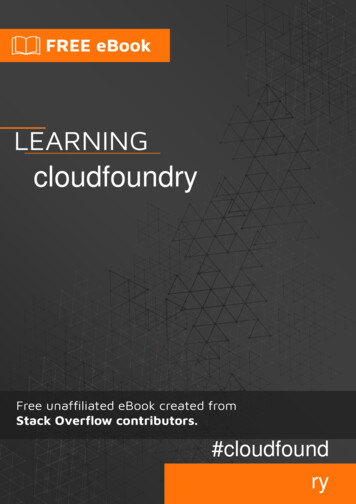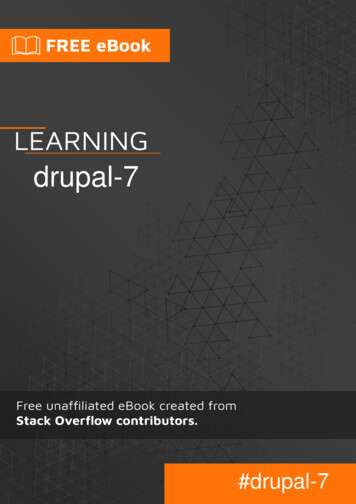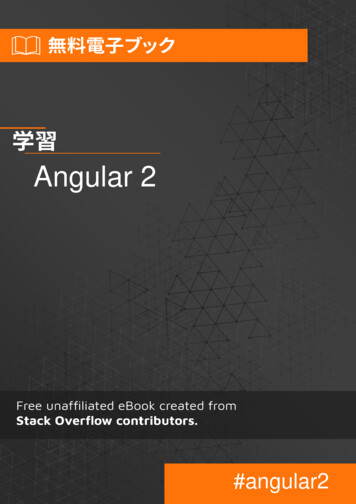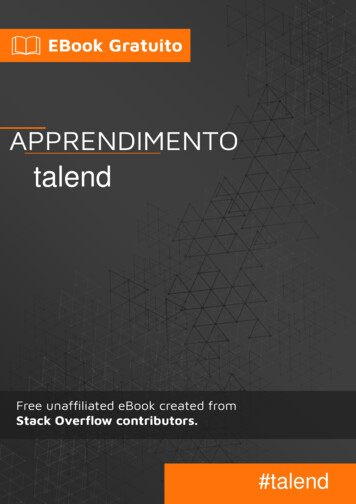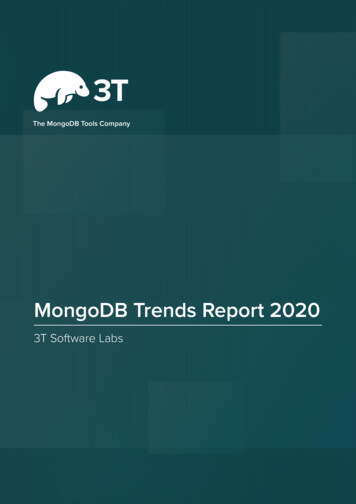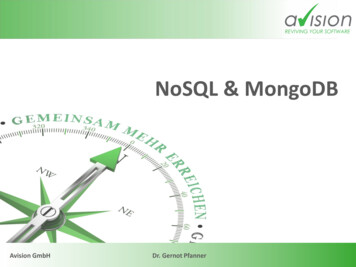
Transcription
MongoDB#mongodb
Table of ContentsAbout1Chapter 1: Getting started with lo World6Complementary Terms6Execution of a JavaScript file in MongoDB7Making the output of find readable in shell7Basic commands on mongo shell8Chapter 2: 2dsphere IndexExamplesCreate a 2dsphere IndexChapter 3: Remarks10Examples10Count10Sum11Average12Operations with arrays.13Match13Remove docs that have a duplicate field in a collection (dedupe)14Chapter 4: Authentication Mechanisms in MongoDB15Introduction15Examples15Authentication Mechanisms15
Chapter 5: Backing up and Restoring DataExamples1616mongoimport with JSON16mongoimport with CSV16Chapter 6: Backing up and Restoring DataExamples1818Basic mongodump of local default mongod instance18Basic mongorestore of local default mongod dump18Chapter 7: Bulk Operations19Remarks19Examples19Converting a field to another type and updating the entire collection in BulkChapter 8: Collections1922Remarks22Examples22Create a Collection22Drop Collection23Chapter 9: Configuration24Parameters24Examples26Starting mongo with a specific config fileChapter 10: CRUD date28Delete28Read29More update operators30"multi" Parameter while updating multiple documents30Update of embedded documents.31
Chapter 11: Getting database informationExamples3232List all databases32List all collections in database32Chapter 12: Indexes33Syntax33Remarks33Examples33Single field33Compound33Delete33List34Index Creation Basics34Hashed indexes36Dropping/Deleting an Index36Get Indices of a Collection37Unique Index37Sparse indexes and Partial indexes37Chapter 13: Java DriverExamples3939Create a tailable cursor39Create a database user39Fetch Collection data with condition39Chapter 14: Managing MongoDB41ExamplesListing currently running queriesChapter 15: Mongo as a Replica SetExamplesMongodb as a Replica SetChapter 16: Mongo as a Replica SetExamplesCheck MongoDB Replica Set states4141424242444444
Chapter 17: Mongo as ShardsExamplesSharding Environment SetupChapter 18: MongoDB - Configure a ReplicaSet to support TLS/SSL46464648Introduction48Examples48How to configure a ReplicaSet to support TLS/SSL?48Create the Root Certificate48Generate the Certificate Requests and the Private Keys48Sign your Certificate Requests49Concat each Node Certificate with its key49Deploy your ReplicaSet50Deploy your ReplicaSet for Mutual SSL / Mutual Trust50How to connect your Client (Mongo Shell) to a ReplicaSet?50No Mutual SSL50With Mutual SSL51Chapter 19: MongoDB AggregationExamples5353Aggregate query examples useful for work and learning53Java and Spring example57Get sample data58Left Outer Join with aggregation ( Lookup)58Chapter 20: MongoDB Authorization Model60Introduction60Examples60Build-in RolesChapter 21: Pluggable Storage Engines6061Remarks61Examples61MMAP61WiredTiger61
How to use WiredTiger 2Chapter 22: Python Driver63Syntax63Parameters63Examples63Connect to MongoDB using pymongo63PyMongo queries63Update all documents in a collection using PyMongo64Chapter 23: Querying for Data ( Getting Started y Document - Using AND, OR and IN Conditions66find() method with Projection68Find() method with Projection68limit, skip, sort and count the results of the find() method69Chapter 24: ReplicationExamplesBasic configuration with three nodesChapter 25: Update ples73 set operator to update specified field(s) in document(s)73I.Overview73II.What happen if we don't use update operators?73
III. set operator74Chapter 26: Upgrading MongoDB g to 3.4 on Ubuntu 16.04 using aptChapter 27: Upserts and InsertsExamplesInsert a documentCredits7677777778
AboutYou can share this PDF with anyone you feel could benefit from it, downloaded the latest versionfrom: mongodbIt is an unofficial and free MongoDB ebook created for educational purposes. All the content isextracted from Stack Overflow Documentation, which is written by many hardworking individuals atStack Overflow. It is neither affiliated with Stack Overflow nor official MongoDB.The content is released under Creative Commons BY-SA, and the list of contributors to eachchapter are provided in the credits section at the end of this book. Images may be copyright oftheir respective owners unless otherwise specified. All trademarks and registered trademarks arethe property of their respective company owners.Use the content presented in this book at your own risk; it is not guaranteed to be correct noraccurate, please send your feedback and corrections to info@zzzprojects.comhttps://riptutorial.com/1
Chapter 1: Getting started with MongoDBRemarks Data in the world started to grow tremendously after mobile application came in the market.This huge amount of data became almost impossible to handle with traditional relationaldatabase - SQL. NoSQL databases are introduced to handle those data where much moreflexibility came like variable number of columns for each data. MongoDB is one of the leading NoSQL databases. Each collection contains a number ofJSON documents. Any data model that can be expressed in a JSON document can be easilystored in MongoDB. MongoDB is a server-client database. Server usually runs with the binary file mongod andclient runs with mongo. There is no join operation in MongoDB prior to v.3.2, for various philosophical and pragmaticreasons. But Mongo shell supports javascript, so if lookup is not available, one can simulatejoin operations on documents in javascript before inserting. To run an instance in production environment, it's strongly advised to follow the OperationsChecklist.VersionsVersionRelease ps://riptutorial.com/2
ExamplesInstallationTo install MongoDB, follow the steps below: For Mac OS: There are two options for Mac OS: manual install or homebrew.Installing with homebrew:Type the following command into the terminal: brew install mongodb Installing manually: Download the latest release here. Make sure that you are downloading theappropriate file, specially check whether your operating system type is 32-bit or64-bit. The downloaded file is in format tgz.Go to the directory where this file is downloaded. Then type the followingcommand: tar xvf mongodb-osx-xyz.tgzInstead of xyz, there would be some version and system type information. Theextracted folder would be same name as the tgz file. Inside the folder, their wouldbe a subfolder named bin which would contain several binary file along withmongod and mongo. By default server keeps data in folder /data/db. So, we have to create thatdirectory and then run the server having the following commands: #### sudo bashmkdir -p /data/dbchmod 777 /datachmod 777 /data/dbexitTo start the server, the following command should be given from the currentlocation: ./mongodIt would start the server on port 27017 by default. To start the client, a new terminal should be opened having the same directory asbefore. Then the following command would start the client and connect to thehttps://riptutorial.com/3
server. ./mongoBy default it connects to the test database. If you see the line like connecting to:test. Then you have successfully installed MongoDB. Congrats! Now, you cantest Hello World to be more confident. For Windows: Download the latest release here. Make sure that you are downloading the appropriatefile, specially check whether your operating system type is 32-bit or 64-bit.The downloaded binary file has extension exe. Run it. It will prompt an installationwizard. Click Next. Accept the licence agreement and click Next. Select Complete Installation. Click on Install. It might prompt a window for asking administrator's permission. ClickYes.After installation click on Finish.Now, the mongodb is installed on the path C:/Program Files/MongoDB/Server/3.2/bin.Instead of version 3.2, there could be some other version for your case. The path namewould be changed accordingly.directory contain several binary file along with mongod and mongo. To run it from otherfolder, you could add the path in system path. To do it:bin Right click on My Computer and select Properties.Click on Advanced system setting on the left pane.Click on Environment Variables. under the Advanced tab.Select Path from System variables section and click on Edit.Before Windows 10, append a semi-colon and paste the path given above. FromWindows 10, there is a New button to add new path.Click OKs to save changes.Now, create a folder named data having a sub-folder named db where you want to runthe server.Start command prompt from their. Either changing the path in cmd or clicking on Opencommand window here which would be visible after right clicking on the empty spaceof the folder GUI pressing the Shift and Ctrl key together.Write the command to start the server:https://riptutorial.com/4
mongodIt would start the server on port 27017 by default. Open another command prompt and type the following to start client: mongo By default it connects to the test database. If you see the line like connecting to: test.Then you have successfully installed MongoDB. Congrats! Now, you can test HelloWorld to be more confident. For Linux: Almost same as Mac OS except some equivalent command is needed. For Debian-based distros (using apt-get): Import MongoDB Repository key. sudo apt-key adv --keyserver hkp://keyserver.ubuntu.com:80 --recv EA312927gpg: Total number processed: 1\gpg:imported: 1 (RSA: 1) Add repository to package list on Ubuntu 16.04. echo "deb http://repo.mongodb.org/apt/ubuntu xenial/mongodb-org/3.2multiverse" sudo tee /etc/apt/sources.list.d/mongodb-org-3.2.list on Ubuntu 14.04. echo "deb http://repo.mongodb.org/apt/ubuntu trusty/mongodb-org/3.2multiverse" sudo tee /etc/apt/sources.list.d/mongodb-org-3.2.list Update package list. sudo apt-get update Install MongoDB. sudo apt-get install mongodb-org For Red Hat based distros (using yum): use a text editor which you prefer. vi /etc/yum.repos.d/mongodb-org-3.4.repo Paste following text.[mongodb-org-3.4]https://riptutorial.com/5
name MongoDB Repositorybaseurl https://repo.mongodb.org/yum/redhat/ releasever/mongodborg/3.4/x86 64/gpgcheck 1enabled 1gpgkey https://www.mongodb.org/static/pgp/server-3.4.asc Update package list. sudo yum update Install MongoDB sudo yum install mongodb-orgHello WorldAfter installation process, the following lines should be entered in mongo shell (client terminal). db.world.insert({ "speech" : "Hello World!" }); cur db.world.find();x cur.next();print(x["speech"]);Hello World!Explanation: In the first line, we have inserted a { key : value } paired document in the default databasetest and in the collection named world. In the second line we retrieve the data we have just inserted. The retrieved data is kept in ajavascript variable named cur. Then by the next() function, we retrieved the first and onlydocument and kept it in another js variable named x. Then printed the value of the documentproviding the key.Complementary TermsSQL TermsMongoDB TermsDatabaseDatabaseTableCollectionEntity / RowDocumentColumnKey / FieldTable JoinEmbedded DocumentsPrimary KeyPrimary Key (Default key id provided by mongodb itself)https://riptutorial.com/6
Execution of a JavaScript file in MongoDB./mongo localhost:27017/mydb myjsfile.jsExplanation: This operation executes the myjsfile.js script in a mongo shell that connects to themydb database on the mongod instance accessible via the localhost interface on port 27017.localhost:27017 is not mandatory as this is the default port mongodb uses.Also, you can run a .js file from within mongo console. load("myjsfile.js")Making the output of find readable in shellWe add three records to our collection test as: ":"val3"})WriteResult({ "nInserted" : 1 }) 3":"val31"})WriteResult({ "nInserted" : 1 }) 3":"val33"})WriteResult({ "nInserted" : 1 })If we see them via find, they will look very ugly. db.test.find(){ " id" : ObjectId("5790c5cecae25b3d38c3c7ae"), "key" : "value1", "key2" : "Val2", "key3" : "val3" }{ " id" : ObjectId("5790c5d9cae25b3d38c3c7af"), "key" : "value2", "key2" : "Val21", "key3" : "val31" }{ " id" : ObjectId("5790c5e9cae25b3d38c3c7b0"), "key" : "value3", "key2" : "Val22", "key3" : "val33" }To work around this and make them readable, use the pretty() function. db.test.find().pretty(){" id" : ObjectId("5790c5cecae25b3d38c3c7ae"),"key" : "value1","key2" : "Val2","key3" : "val3"}{" id" : ObjectId("5790c5d9cae25b3d38c3c7af"),"key" : "value2","key2" : "Val21","key3" : "val31"}{" id" : ObjectId("5790c5e9cae25b3d38c3c7b0"),"key" : "value3","key2" : "Val22","key3" : "val33"https://riptutorial.com/7
} Basic commands on mongo shellShow all available databases:show dbs;Select a particular database to access, e.g. mydb. This will create mydb if it does not already exist:use mydb;Show all collections in the database (be sure to select one first, see above):show collections;Show all functions that can be used with the database:db.mydb.help();To check your currently selected database, use the command db dbmydbdb.dropDatabase()command is used to drop a existing database.db.dropDatabase()Read Getting started with MongoDB online: tarted-with-mongodbhttps://riptutorial.com/8
Chapter 2: 2dsphere IndexExamplesCreate a 2dsphere Indexdb.collection.createIndex()method is used to create a 2dsphere index. The blueprint of a 2dsphere
Now, the mongodb is installed on the path C:/Program Files/MongoDB/Server/3.2/bin. Instead of version 3.2, there could be some other version for your case. The path name would be changed accordingly. bin directory contain several binary file along with mongod and mongo. To run it from other folder, you could add the path in system path. To do it:

